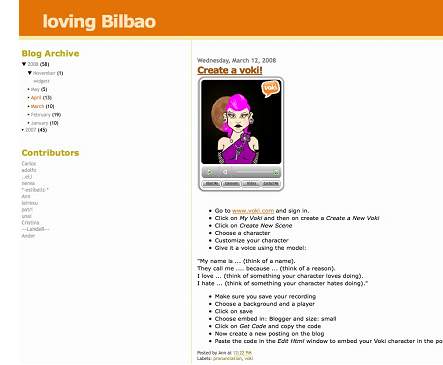Using Fun Web Publishing Resources for Project and Task-based Work
Ann Foreman, Spain
Ann Foreman is interested in exploring the potential of new technologies in language learning. She has produced an award winning CD-ROM, English with the Finglies, designed as a teaching-aid for primary school children learning English and currently works as the Information and Communication Technology Coordinator at the British Council in Bilbao, Spain. E-mail: foreman@ydemas.com
Menu
Introduction
Going beyond the confines of the classroom
Tasks that have real outcomes
For some years now whenever I’ve started up with a new group of students, I’ve set up a class blog with them. Gradually, by finding fun resources on the internet that inspire me and encourage students’ creative capacities, and by putting together tasks on the blog that utilise them, I’ve hit on a working method of that seems to work very well for both me and my students.
A class blog helps take the spotlight off me. Setting one up is a collaborative effort between me and my students. They decide on the blog’s name, choose its design and invite themselves to become members. This involves them right from the start and encourages them see the blog as their space.
I make their first task on the blog something I know they will enjoy, such as choosing a singer or group they admire that sings in English. I demonstrate how to create and edit a post; select a video of their group from YouTube, embed it in the post and add a link to the lyrics of the song. Finally, the students do all this plus write about why they think their group has succeeded in becoming famous.

Every week or so I put a task like this on the blog for students to work on during class – or like the one in the screenshot for creating a voki. This gives me precious time to talk to students individually. While the rest of the class is busy working on the task in hand, I can chat with each student about the previous one they’ve completed: commenting on the language they’ve used or, if it’s a speaking task – like the one with Voki – their pronunciation. For me, this has a very different dynamic to collecting in home or class work and correcting it. With the student sitting next to me I can simply pause when I find a problem in their work and give them the opportunity to arrive at the solution themselves.
I also encourage students to make comments on each other’s posts. So for me the blog becomes the class organiser, letting me become more of a facilitator, and a spirit of collaboration is established in class where each student’s contribution generates material for the rest of us to discuss.
There’s an ever increasing range of web publishing resources available on the Internet that you can use either independently or in conjunction with blogs. Three I can really recommend for task-based work are Voki, VoiceThread and Animoto:
Voki - www.voki.com - lets you create animated characters that speak. Get your students to design a character and give it a voice: for example, introducing him/herself and saying what s/he loves and hates doing.
VoiceThread - http://voicethread.com - enables you to select photos or other images and talk about them. Get your students to present a recipe or tell a personal anecdote illustrated by photos. Its also a great way for practising for the Cambridge exams.
Animoto - http://animoto.com - enables you to create a smart video out of photos. Get your students to select photos about a subject that interests them, create a video, then interview each other.
All three are free and simple to use. You can find a tutorial on each of them plus ideas for exploiting them in the classroom on my blog Encouraging learner Autonomy - http://encouraginglearnerautonomy.blogspot.com
When utilising web resources like these, students learn to follow instructions and employ a range of skills to negotiate with the real world, as you can see here with this page from Voki.

Another advantage of working with multi-media is that it gives students who aren’t academically gifted and express themselves best through images or sound, a chance to shine.
I make tasks as open as possible so that students can choose and develop the content that most interests them. Instead of me as a teacher imposing on them the language I think they should be practising, the learning process becomes more organic. Because students are more motivated, they tend to reflect more on what they know so as to find the best way of expressing what they want to say. It’s extremely gratifying to continually hear them asking me and each other: “How do you say this in English?”
Finally, their work has a real outcome: it is published on the internet for all the world to see. As such students take far more pride in their work and have the opportunity to show what they’ve achieved in class to their friends and family.

Please check the How to Use Technology in the Classroom course at Pilgrims website.


|